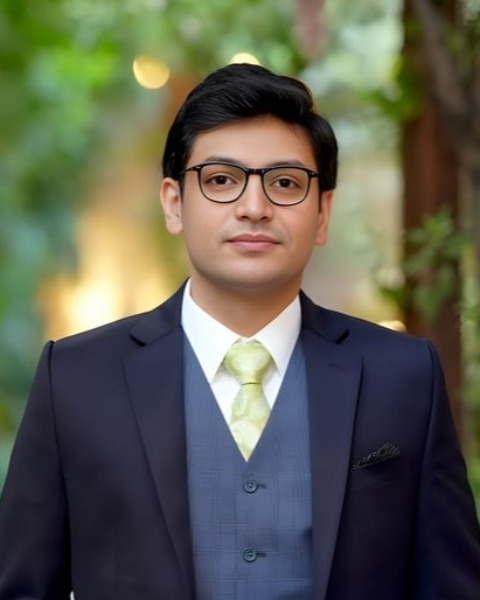Cardiovascular Engineering
Cardiovascular Engineering- Poster Session D
Poster U11 - Studying cardiac innervation using iPSC derived 3D neurocardiac model
Friday, October 25, 2024
3:30 PM - 4:30 PM EST
Location: Exhibit Hall E, F & G

Muhammad A. Tayyab (he/him/his)
Graduate Student
Binghamton University SUNY
Binghamton, New York, United States- TH
Tracy Hookway, PhD (she/her/hers)
Assistant Professor
Binghamton University, New York, United States
Presenting Author(s)
Primary Investigator(s)
Introduction: Human cardiac activity is under the control of the autonomic nervous system with sympathetic neurons being excitatory in nature and parasympathetic neurons inhibitory in nature. Both sympathetic and parasympathetic nerves originate in the hind brain. Sympathetic nerves relay signals to post-ganglionic nerve fibers in intrathoracic extracardiac ganglia which innervate the cardiac tissue while parasympathetic nerve fibers make synapses with the post-ganglionic nerve fibers in the intrinsic cardiac ganglia. A balance between the sympathetic and para-sympathetic activity keeps the heart rate in check and allows the body to respond to subtle changes in cardiac demand. Disturbances in sympathetic and para-sympathetic control of the heart are considered predominant factors in many cardiac channelopathies yet the field lacks a good model system to be able to study the role of innervation on cardiac function in health and disease. This study aims to develop a 3D iPSC derived neurocardiac model to study the role of innervation on cardiomyocyte phenotype and function.
Materials and
Methods: Caudalized brain spheroids were generated using the protocol adapted from Andersen et al. 2020. iPSCs were aggregated in round-bottom ultra-low attachment plates and subjected to dual SMAD inhibition for five days followed by Wnt signaling activation on day 3 and hedgehog activation on day 11 through day 19. Notch signaling was inhibited from day 19 to day 24. And subsequently the spheroids were maintained in neural media. Cardiomyocytes were differentiated by modulating Wnt signaling as previously described by Lian et al. 2013. To generate 3D cardiac spheroids, 22 day old beating cardiomyocytes were aggregated using round-bottom ultra-low attachment plate. Neurocardiac coculture was then achieved by placing 45 day old caudalized brain spheroids and 3 day old 3D cardiac spheroids in contact within round-bottomed well in 1:1 ratio of neural and cardiac media. Within 24 hours caudalized brain spheroids and cardiac aggregates fused with each other and were transferred to flat bottom low attachment plates. Neurocardiac cocultures were maintained for 11 days and calcium imaging was performed. Immunohistochemistry was done to evaluate the neuronal population (neurofilament expression) in caudalized brain spheroids. Cardiac tissue beating was quantified using open-source ImageJ plugin MUSCLEMOTION
Results, Conclusions, and Discussions: Differentiated caudalized brain spheroids contained abundant neurons as seen by neurofilament expression (Figure 1A). After 11 days of neurocardiac coculture the cardiac spheroid and caudalized brain spheroid merged together (Figure1C), Analysis of the cardiac contraction revealed a statistically significant decrease in duration and amplitude of cocultured cardiac tissue in comparison to independent monocultured cardiac aggregates (Figure 2A & B). A mild increase in peak-to-peak time in cocultured cardiac tissue was also observed compared to cardiac monocultures (Figure 2C), which correlates to a decrease in beating rate in the neurocardiac tissues. Taken together, a decrease in contraction duration, contraction amplitude and beat rate are all signs of nascent cardiomyocyte maturity. Results of this study indicate that coculturing caudalized brain spheroids with cardiac tissue alters the cardiac tissue function and may aid in maturation of the iPSC-derived cardiomyocytes. Ongoing work aims to further validate these findings by characterizing the neuronal population and understanding how both the cardiomyocyte and neuronal phenotypes are impacted through this co-culture neurocardiac model. Future directions also include adding neuronal populations mimicking both sympathetic and parasympathetic cardiac neurons.
Acknowledgements (Optional): The authors would like to thank the Binghamton Advanced Diagnostic Laboratory, William Terrell, Kirk Butler, Natalie Weiss-Pachter, Haleema Qamar, and Jacob Gershan for project support. This project was made possible by funding from National Science Foundation (CAREER EBMS 2237898) and the National Institutes of Health (1R15HL140745).
